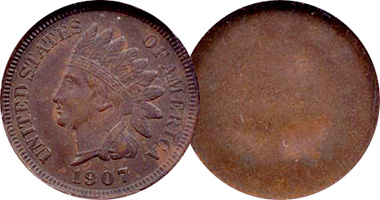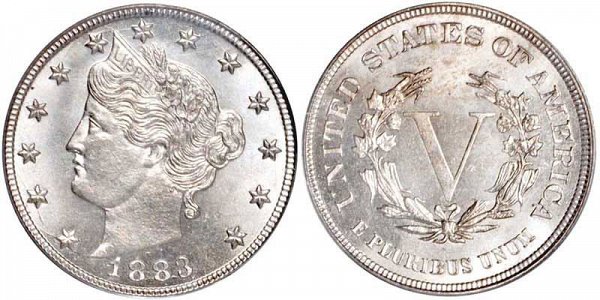One-Sided Nickels Guide
We're here to explain how one-sided coins occur and how valuable a one-sided nickel may (or may not) be.

Image of a uniface Indian Head penny courtesy of Sullivan Numismatics
Types of One-Sided Nickels
Also known as uniface coins, a coin with a design on only one side can occur for two reasons:
1. The result of an error at the mint that made the coin
2. The result of damage that happens after being minted
Minting Errors
Mistakes that occur at the mint create "error coins." These are the types of error coins that are potentially worth a lot of money.
Error coins are especially rare because they are never intended to leave the mint. The fact that they make it into circulation is an unusual oversight. Finding a genuine one-sided nickel error is indeed a very rare occurrence.
Here are two kinds of mint errors that could result in a one-sided nickels:
- Brockage: This happens when a coin gets stuck to another coin during the minting process. While the usual result is a mirror image of the design appearing on the opposite side of the coin, one side of the coin may have such faint details that it appears blank.
- Die cap error: This occurs when the planchet gets stuck to the hammer die used to strike the coin. Not only does this leave one side of the coin blank, but it also gives it a shape resembling a bottle cap.
You can learn even more about uniface error coins from resources like CoinQuest.com.
Damage After Minting
Unfortunately, coins that are damaged after leaving the mint are worth virtually nothing. Any post-mint damage that results in a one-sided coin is not considered valuable. How can you tell if this is the case? Here's how it can happen:
- Circulation wear: Extreme wear can obscure one side of a coin. This is likely the most common cause of all uniface coins in existence—making the true error coins that much more rare and valuable.
- Accidental damage: Coins that endure bending, breaking, or other forms of physical damage may end up with a one-sided design.
One-Sided Nickels May Be Pattern Coins
A pattern coin (or simply "pattern") is made when the mint wants to test a new coin design or a new coin composition. It's like a proof-of-concept. Over the years the U.S. Mint has struck several batches of these trial pieces before officially approving a new coin for mass production.
As you might imagine, patterns can be prone to various errors, including being uniface. They are not intended for circulation; normally the only people who receive pattern coins are mint employees and politicians. Sometimes a few patterns find their way to the general public.
One noteworthy example of this happened with some patterns of the Liberty Head nickel (also popularly called the "V nickel") in 1881 and 1882.

Example of a Liberty Head nickel, also known as a "V nickel."
Value of One-Sided Nickels
Due to their rarity, genuine one-sided nickels can sell for $1,000 or more. However, they will need to be authenticated by a third-party grading company such as PCGS or NGC. This ensures that the coin is actually an error rather than a damaged coin. The experts at grading companies can determine if a one-sided coin is simply a result of accidental or purposeful damage.
The condition of the coin will impact its value. This may seem an odd thing to say, given that error coins already look like something is "off"—such as one side missing the design! Nonetheless, a skilled coin grader can evaluate how pristine the condition of a one-sided nickel is.
Beyond its condition and absolute rarity, a one-sided nickel's value will also depend upon how much demand there is from coin collectors. Interest in and demand for a particular type of error coin can fluctuate over time. It's hard to say definitively how much a given one-sided nickel is worth due to how uncommon they are. You should check recent auctions for similar coins from auction houses such as Heritage to get an idea of the current market.
Collecting One-Sided Coins
Here are some tips for anyone interested in collecting error coins like one-sided nickels:
Read more about collecting valuable nickels from our numismatic experts:
Coin Glossary: Most Important Coin Collecting Terminology
What Is a Silver Nickel Worth? (More Than You'd Expect!)
Buffalo Nickel Values and Price Charts (1913–1938)
No Date Buffalo Nickels: How to Find Their Value
1936-D 3-1/2 Legs Buffalo Nickels: The Strange Story (& Value)
15 Most Valuable Jefferson Nickels: Complete Price Guide

Everett Millman
Everett has been the head content writer and market analyst at Gainesville Coins since 2013. He has a background in History and is deeply interested in how gold and silver have historically fit into the financial system.
In addition to blogging, Everett's work has been featured in Reuters, CNN Business, Bloomberg Radio, TD Ameritrade Network, CoinWeek, and has been referenced by the Washington Post.
